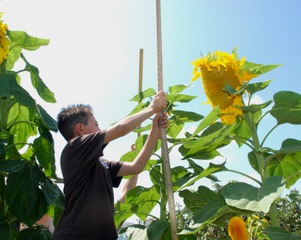For specific grade level ideas linking the garden with the math curriculum, print a hard copy of Common Core Math and English Language Arts Standards We Can Frequently Reinforce in Gardening, Cooking and Tasting Activities.
The garden will support students as they learn to count, measure, perform the basic operations with whole numbers and fractions, calculate perimeter and area, use percentages and explore our economic system. For younger students, you can use the garden for counting, sorting, comparing, and charting. The garden provides a real-world environment for students to:
-
- Sprout an avocado seed or sweet potato in water. Then measure and chart the root and top growth.
- Count the number of seeds planted and the number that sprout. Subtract the number that are thinned or die.
- Use the garden to teach beginning measurement.
- Sell produce in a classroom farmer’s market to teach money concepts and the use of currency.

Older students can expand their math skills by:
-
- Recording measurements in the garden using the metric system.
- Charting daily soil and air temperature, then graphing, and computing averages.
- Graphing and computing average rainfall levels using a rain gauge.
- Making a sundial.
- Measuring the length and change in direction of shadows over the course of a day; comparing with measurements taken in different seasons.
- Applying measurement concepts to area, perimeter, fractions, and percentages.
- Using Square Foot Gardening to apply measurement principles.
- Learning economics and business concepts by selling produce or flowers from the garden.
- Practicing scale drawing for garden designs.